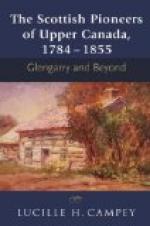On the 24th of August, 1793, Mackenzie was back again at Fort Chipewayan, after an absence of eleven months, having been the first white man to cross the broad continent of North America from the Atlantic to the Pacific, north of Mexico.
CHAPTER XII
Mackenzie’s Successors
The Spaniards of California had been aware in the middle of the eighteenth century that there was a big river entering the sea to the north of the savage country known as Oregon. The estuary of this river was reached in May, 1792, by an American sea captain of a whaling ship—ROBERT GRAY, of Boston. He crossed the bar, and named the great stream after his own ship, the Columbia. Five months afterwards (October, 1792) Lieutenant BROUGHTON, of the Vancouver expedition, entered the Columbia from the sea, explored it upstream for a hundred miles, and formally took possession of it for the King of Great Britain. The news of this discovery reached Alexander Mackenzie (no doubt after his return from his overland journey to the Pacific coast), and he at once jumped to the conclusion that the powerful stream he had discovered in the heart of the Rocky Mountains, and had partially followed on its way to the Pacific, must be the Columbia. As a matter of fact it was the river afterwards called Fraser.
If you look at the map of British North America, and then at the map of Russian Asia—Siberia—you will notice a marked difference in the arrangement of the waterways. Those of the Canadian Dominion, on the whole, flow more eastwards and westwards, or at any rate radiate in all directions, so as to constitute the most wonderful system of natural canals possessed by any country or continent. On the contrary, the rivers of Siberia flow usually in somewhat parallel lines from south to north. Siberia also is far less well provided than British North America with an abundance of navigable rivers, streams, and great lakes. Therefore the traveller in pre-railway days wishing to cross Siberia from west to east or east to west was obliged to have recourse to wheeled traffic, to ride, or to walk. Consequently, until




